1998 PONTIAC BONNEVILLE service indicator
[x] Cancel search: service indicatorPage 125 of 395
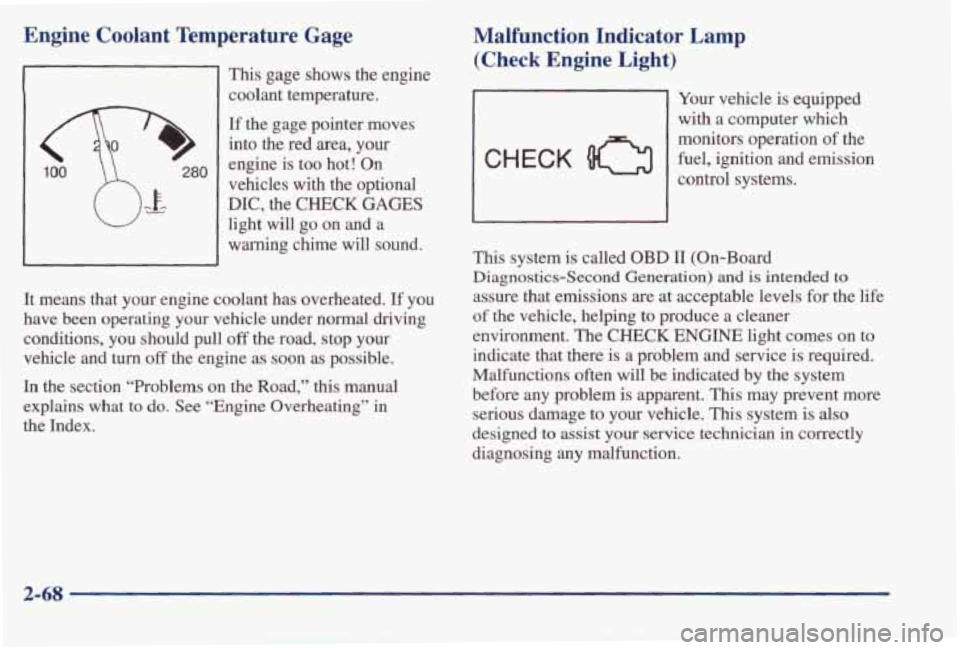
Engine Coolant Temperature Gage
280
This gage shows the engine
coolant temperature.
If the gage pointer moves
into
the red area, your
engine is too hot! On
vehicles
with the optional
DIC, the CHECK GAGES
light will go on and a
warning chime will sound.
It means that your engine coolant has overheated.
If you
have been operating your vehicle under normal driving
conditions, you should pull
off the road, stop your
vehicle and
turn off the engine as soon as possible.
In the section “Problems
on the Road,” this manual
explains what to
do. See “Engine Overheating” in
the Index.
Malfunction Indicator Lamp (Check Engine Light)
CHECK 0
Your vehicle is equipped
with a computer which
monitors operation of the
fuel, ignition and emission
control systems.
This system is called OBD II (On-Board
Diagnostics-Second Generation)
and is intended to
assure that emissions are at acceptable levels for the life
of the vehicle, helping to produce a cleaner
environment. The
CHECK ENGINE light comes on to
indicate that there is a problem and service is required.
Malfunctions often will be indicated by the system
before any problem is apparent. This may prevent more
serious damage to your vehicle. This system is also
designed to assist your service technician in correctly
diagnosing any malfunction.
2-68
Page 170 of 395
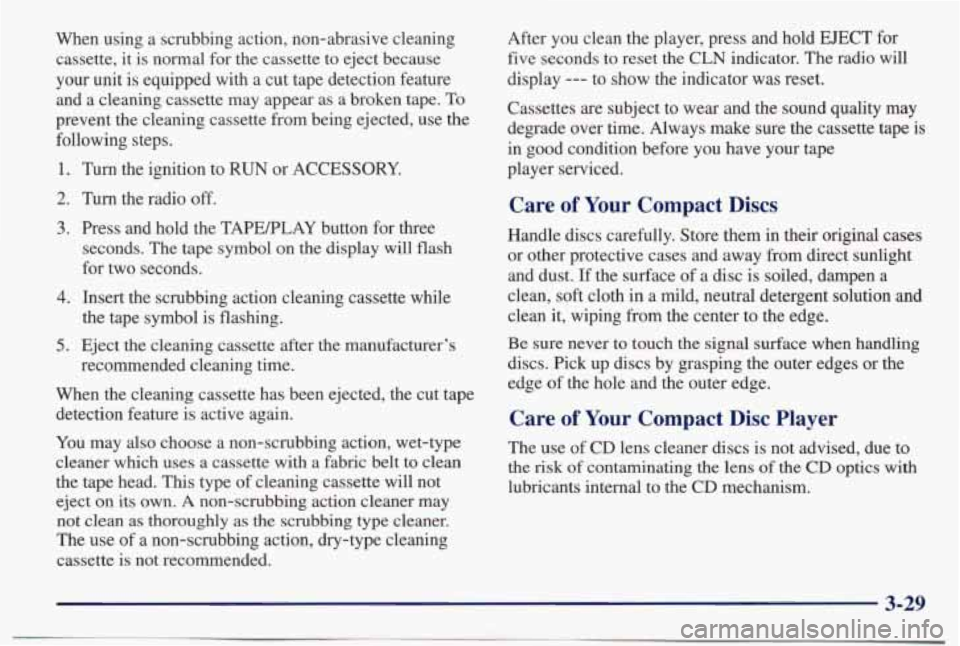
When using a scrubbing action, non-abrasive cleaning cassette, it is normal for the cassette to eject because
your unit is equipped with a cut tape detection feature
and a cleaning cassette may appear as a broken tape.
To
prevent the cleaning cassette from being ejected, use the
following steps.
1.
2.
3.
4.
5.
Turn the ignition to RUN or ACCESSORY.
Turn the radio
off.
Press and hold the TAPEPLAY button for three
seconds. The tape symbol on the display will flash
for two seconds.
Insert the scrubbing action cleaning cassette while
the tape symbol is flashing.
Eject the cleaning cassette after the manufacturer’s
recommended cleaning time.
When the cleaning cassette has been ejected, the cut tape
detection feature is active again.
You may
also choose a non-scrubbing action, wet-type
cleaner which uses a cassette with a fabric belt to clean
the tape head.
This type of cleaning cassette will not
eject on
its own. A non-scrubbing action cleaner may
not clean as thoroughly
as the scrubbing type cleaner.
The use of a non-scrubbing action, dry-type cleaning
cassette is not recommended. After you clean
the player, press and hold
EJECT for
five seconds to reset the CLN indicator. The radio will
display
--- to show the indicator was reset.
Cassettes are subject to wear and the sound quality may
degrade over time. Always make sure the cassette tape is
in good condition before you have your tape
player serviced.
Care of Your Compact Discs
Handle discs carefully. Store them in their original cases
or other protective cases and away from direct sunlight and dust.
If the surface of a disc is soiled, dampen a
clean, soft cloth in a mild, neutral detergent solution
and
clean it, wiping from the center to the edge.
Be sure never to touch
the signal surface when handling
discs. Pick up discs by grasping the outer edges or the
edge of the hole and the outer edge.
Care of Your Compact Disc Player
The use of CD lens cleaner discs is not advised, due to
the
risk of contaminating the lens of the CD optics with
lubricants internal to the CD mechanism.
3-29
Page 255 of 395
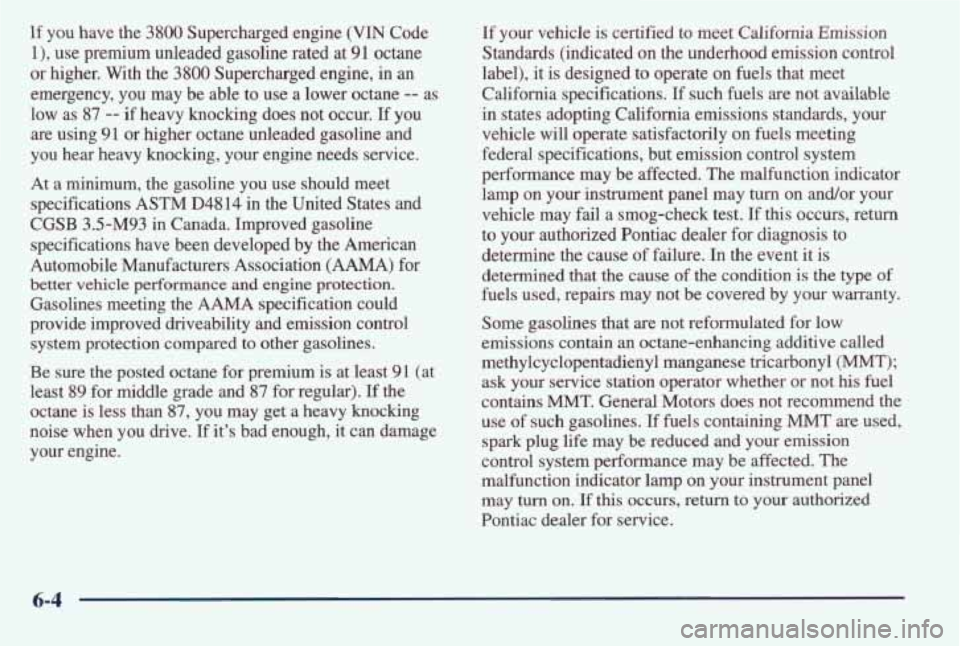
If you have the 3800 Supercharged engine (VIN Code
l), use premium unleaded gasoline rated at 91 octane
or higher. With the
3800 Supercharged engine, in an
emergency, you may be able to use a lower octane -- as
low as
87 -- if heavy knocking does not occur. If you
are using
91 or higher octane unleaded gasoline and
you hear heavy knocking, your engine needs service.
At a minimum, the gasoline you use should meet specifications
ASTM D4814 in the United States and
CGSB 3.5-M93 in Canada. Improved gasoline
specifications have been developed by the American
Automobile Manufacturers Association
(AAMA) for
better vehicle performance and engine protection.
Gasolines meeting the AAMA specification could
provide improved driveability and emission control
system protection compared to other gasolines.
Be sure the posted octane for premium is at least
91 (at
least
89 for middle grade and 87 for regular). If the
octane is less than
87, you may get a heavy knocking
noise when you drive. If it’s bad enough, it can damage
your engine.
If your vehicle is certified to meet California Emission
Standards (indicated
on the underhood emission control
label), it is designed to operate on fwels that meet
California specifications. If such fuels are not available
in states adopting California emissions standards, your vehicle will operate satisfactorily
on fuels meeting
federal specifications, but emission control system
performance may be affected. The malfunction indicator lamp on your instrument panel may
turn on and/or your
vehicle may fail a smog-check test. If this occurs, return
to
your authorized Pontiac dealer for diagnosis to
determine the cause of failure.
In the event it is
determined that the cause of the condition
is the type of
fuels used, repairs
may not be covered by your warranty.
Some gasolines that are not reformulated
for low
emissions contain
an octane-enhancing additive called
methylcyclopentadienyl manganese tricarbonyl
(MMT);
ask your service station operator whether or not his fuel
contains
MMT. General Motors does not recommend the
use of such gasolines. If fuels containing MMT are used,
spark plug life may be reduced and your emission
control system performance may be affected. The
malfunction indicator lamp
on your instrument panel
may
turn on. If this occurs, return to your authorized
Pontiac dealer for service.
6-4
Page 281 of 395
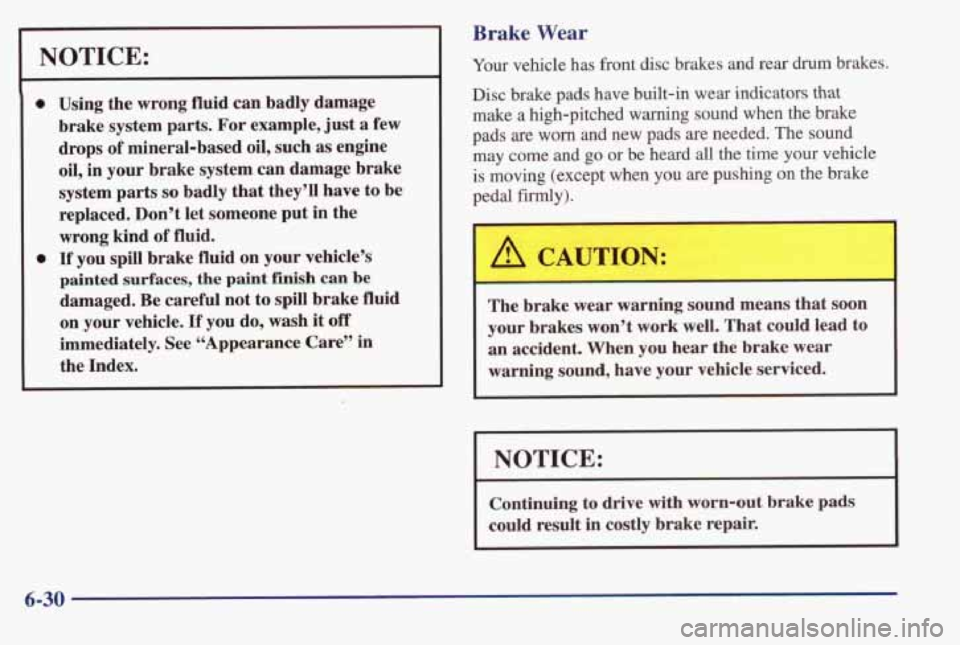
-
NOTICE:
0
0
Using the wrong fluid can badly damage
brake system parts. For example, just a few
drops
of mineral-based oil, such as engine
oil, in your brake system can damage brake
system parts
so badly that they’ll have to be
replaced. Don’t let someone put in the
wrong kind
of fluid.
If you spill brake fluid on your vehicle’s
painted surfaces, the paint finish can be
damaged. Be careful not to spill brake fluid
on your vehicle. If you do, wash it off
immediately. See “Appearance Care” in
the Index.
Brake Wear
Your vehicle has front disc brakes and rear drum brakes.
Disc brake pads have built-in wear indicators
that
make a high-pitched warning sound when the brake
pads are worn and new pads are needed. The sound
may come
and go or be heard all the time your vehicle
is moving (except when
you are pushing on the brake
pedal
firmly).
A 3
,A CAUTION:
I I
The brake wear warning sound means that soon
your brakes won’t work well. That could lead to
an accident. When you hear the brake wear
warning sound, have your vehicle serviced.
I I
I NOTICE: I ~
Continuing to drive with worn-out brake pads
could result
in costly brake repair. I
6-30
Page 295 of 395
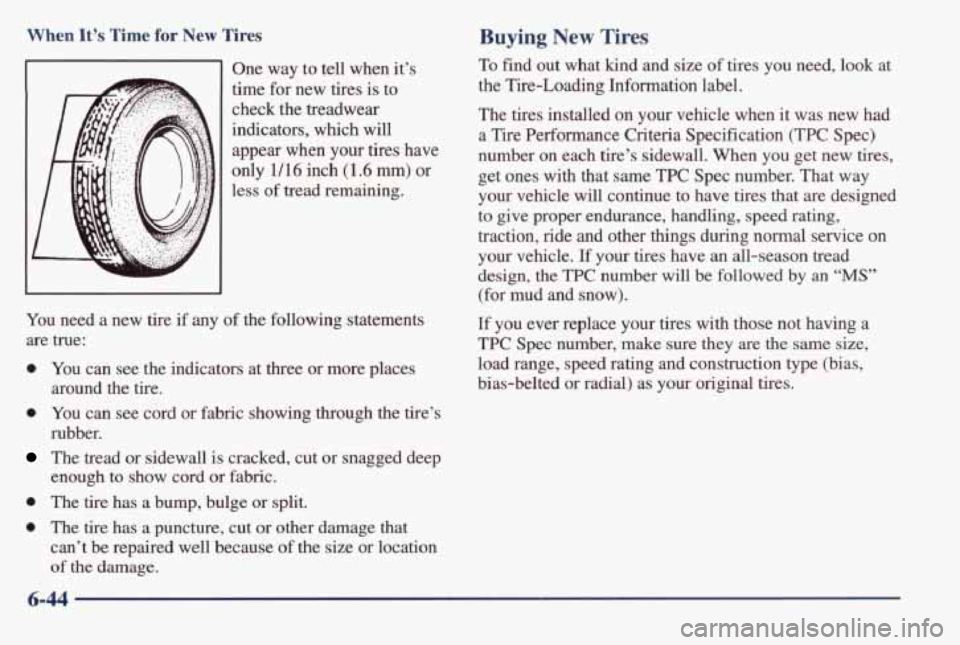
When It’s Time for New Tires
One way to tell when it’s
time for
new tires is to
check the treadwear
indicators, which will
appear when your tires have
only 1/16 inch
(1.6 mm) or
less of tread remaining.
You need a
new tire if any of the following statements
are true:
0 You can see the indicators at three or more places
0 You can see cord or fabric showing through the tire’s
The tread or sidewall is cracked, cut or snagged deep
around the tire.
rubber.
enough to show cord or fabric.
0 The tire has a bump, bulge or split.
0 The tire has a puncture, cut or other damage that
can’t be repaired well because of the size or location
of the damage.
Buying New Tires
To find out what kind and size of tires you need, look at
the Tire-Loading Information label.
The tires installed on
your vehicle when it was new had
a Tire Performance Criteria Specification
(TPC Spec)
number on each tire’s sidewall. When you get new tires,
get
ones with that same TPC Spec number. That way
your vehicle will continue to have tires that are designed
to give proper endurance, handling, speed rating,
traction, ride and other things during normal service on
your vehicle.
If your tires have an all-season tread
design,
the TPC number will be followed by an “MS”
(for mud and snow).
If
you ever replace your tires with those not having a
TPC Spec number, make sure they are the same size,
load range, speed rating and construction type (bias,
bias-belted or radial) as your original tires.
6-44
Page 380 of 395

Low Washer Fluid Light ......................... 2-72
Lubricants and Fluids
............................ 7-37
Lubrication Service. Body
........................ 7-32
Lumbar Controls
................................ 1-3
Magnasteer
................................ 4. 10
Maintenance Record
............................ 7-39
Maintenance Schedule
............................ 7- 1
Long Tripmghway Definition ................... 7-6
Long Trip/Highway Intervals
..................... 7-6
Owner Checks and Services
..................... 7-31
Periodic Maintenance Inspections
................ 7-35
Recommended Fluids and Lubricants
............. 7-37
Scheduled Maintenance Services
.................. 7-4
Short Trip/City Definition
....................... 7-5
Short Trip/City Intervals
........................ 7-5
Maintenance. Underbody ......................... 6-55
Maintenance When Trailer Towing
................. 4-38
Malfunction Indicator Lamp
...................... 2-68
Manual Front Seat
............................... 1-2
Manual Rgmote Control Mirror
.................... 2-49
Maxifuse Relay Center
......................... 6-59
Methanol
...................................... 6-5
Mirrors
....................................... 2-48
Convex Outside
.............................. 2-50
Electrochromic Daymight Rearview .............. 2-49
Inside Daymight Rearview
..................... 2-48
Manual Remote Control ........................ 2-49
Power Remote Control
......................... 2-50
Visorvanity ................................. 2-53
MMT ......................................... 6-4
Mountain Roads
................................ 4-23
Maintenance. Normal Replacement Parts
............ 6-66
Net.
Convenience
.............................. 2-52
Neutral. Automatic Transaxle
..................... 2-25
New Vehicle Break-In
........................... 2-19
Night Vision ................................... 4-16
Normal Maintenance Replacement Parts
............. 6-66
Odometer
........ ............ ...... 2-61
Odometer. Trip
................................. 2-61
Off-RoadRecovery
............................. 4-12
Oil. Engine .................................... 6-13
Oil Level Warning Light
......................... 2-72
Oil. Supercharger ............................... 6-19
Overdrive. Automatic Transaxle
........ ...... 2-26
Overheating Engine
............................. 5-15
Owner Checks and Services
....................... 7-31
Owner Publications. Ordering
..................... 8-13
Paint Spotting. Chemical ........................ 6-55
Park Automatic
Transaxle .......................... 2-24
Shifting Into ................................. 2-29
Shiftingoutof
............................... 2-32
AtNight .................................... 2-15
Brake
...................................... 2-28
Brake Mechanism Check
....................... 7-34
Lots
....................................... 2-16
Over Things That
Burn ........................ 2-33
WithaTrailer
................................ 4-37
Passing
..&.................................... 4-13
PASS-Key 11 ................................. 2-18
Performance Shifting
............................ 2-27
Periodic Maintenance Inspections
.................. 7-35
Parking
9-7
Page 384 of 395
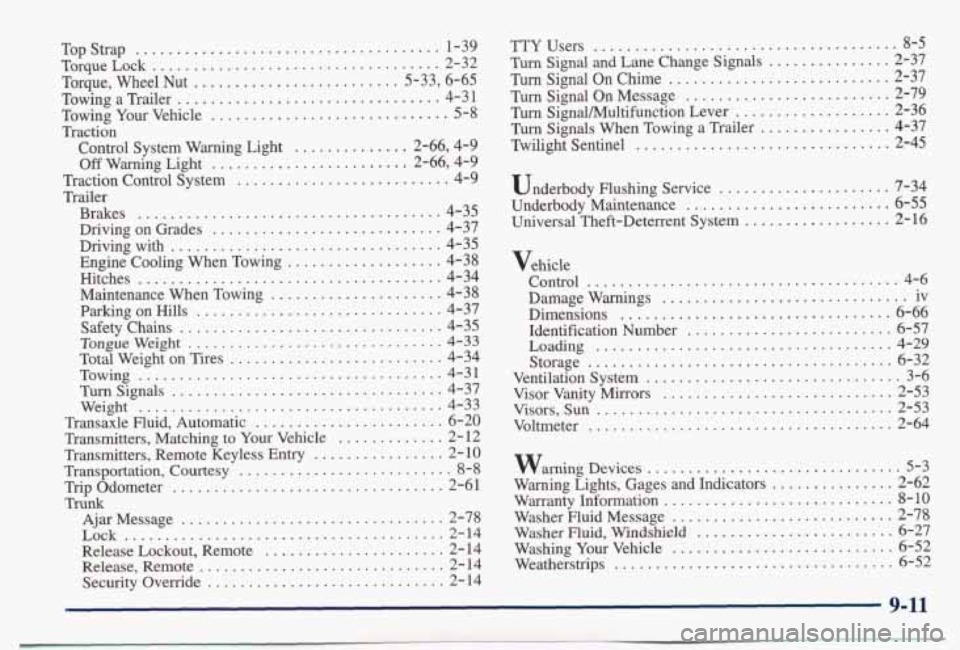
TopStrap ................................... 1-39
TorqueLock ................................... 2-32
Torque, Wheel Nut ......................... 5-33, 6-65
Towing a Trailer ................................ 4-31
Towing Your Vehicle ............................. 5-8
Control System Warning Light ............ 2-66, 4-9
Off Warning Light ........................ 2-66, 4-9
Traction Control Svstem .......................... 4-9
Traction
I
Trailer
Brakes
................................... 4-35
Driving with ................................. 4-35
Engine Cooling When Towing ................... 4-38
Maintenance When Towing ..................... 4-38
Parking on Hills .............................. 4-37
Safety Chains ................................ 4-35
Total Weight on Tires .......................... 4-34
Turn Signals ................................. 4-37
Transaxle Fluid, Automatic ....................... 6-20
Transmitters, Matching to Your Vehicle ............. 2- 12
Transmitters, Remote Keyless Entry ................ 2-10
Transportation, Courtesy .......................... 8-8
Trip Odometer ................................. 2-61
Ajar Message ................................ 2-78
Release Lockout, Remote ...................... 2-14
Release, Remote .............................. 2-14
Driving on Grades ........... ............ 4-37
Hitches ..................................... 4-34
Tongueweight ............................... 4-33
Towing ..................................... 4-31
Weight ..................................... 4-33
Trunk
Lock ....................................... 2-14
SecurityOverride ............................. 2-14
TTY Users ..................................... 8-5
Turn Signal and Lane Change Signals ............... 2-37
Turn Signal On Chime ........................... 2-37
Turn Signal On Message ......................... 2-79
Turn Signal/Multifunction Lever ................... 2-36
Turn Signals When Towing a Trailer ................ 4-37
"light Sentinel ............................... 2-45
Underbody Flushing Service ..................... 7-34
Underbody Maintenance ......................... 6-55
Universal Theft-Deterrent System .................. 2-16
Vehicle
Control
...................................... 4-6
Damage Warnings .............................. iv
Dimensions
................................. 6-66
Identification Number ......................... 6-57
Loading .................................... 4-29
Storage ..................................... 6-32
Ventilationsystem ............................... 3-6
Visor Vanity Mirrors ............................ 2-53
Visors, Sun .................................... 2-53
Voltmeter ..................................... 2-64
warning Devices ............................... 5-3
Warning Lights. Gages and Indicators ............... 2-62
Warranty Information ............................ 8-10
Washer Fluid Message ........................... 2-78
Washer muid. Windshield ........................ 6-27
Washing Your Vehicle ........................... 6-52
Weatherstrips .................................. 6-52
9-11